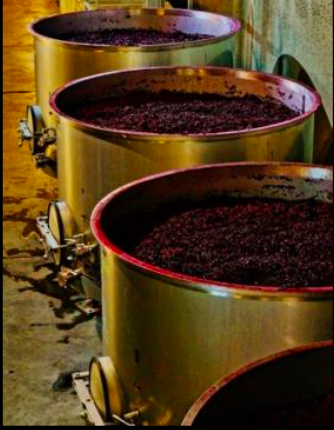
CARBONIC MACERATION MC02
A Carbonic story, but not very sparkling.
Book of Bertil 19.01
Preamble
Today we live in a very special world. A human world that believes the earth is round, but acts as if this earth is flat, linear, without obstacles or constraints. We are in a world that only believes in what is said, repeated, yelled, spat, sworn or conjured. This is the world of "fake news", popular lies. Images and words play a monumental role in how we perceive, judge and ultimately purchase various products. Like it or not, it shapes human behavior in incredible ways.
CHAPTER 1.0
19.01.01 Here is a perfectly extraordinary example
In the 1980s, society discovered the need for physical activity. Do you remember Jane Fonda and her Aerobic Workout? The image becomes more important than all, and your physical look takes precedence over your mental health. So now you had to suffer to fit into social norms. Leanness therefore requires a diet, and here comes Weightwatchers! Then over time we discover that physical health goes through mental health and that Brillat Savarin was right, "Tell me what you eat, and I'll tell you who you are" So it was the beginning of the Natural race, organic at all costs, creating the Whole Food Market empire. But now the industry needs new trends to sell more, to beat the competition, to influence and capture part of the market. And then there is the area of the image, the one with the least possible explanation or tangible and qualitative proof. Hello Face Book, Instagram, TikTok etc. No one asks the question if the information is true and correct, and what will be the impact of our choices or decisions on our life and our health.

19.01.02 In the world of wine ...
Words and images are the essential keys to sales, a race for Millennials. This dream generation who consumes without asking themselves any real existential questions. Health goes through a marginal wine label with as many colors as possible, and with an absolute minimum of information and explanations. This is the ultimate proof that the wine is Natural, Organic, Biodynamic, Sulfite-free, Intrant-free. In this anti-informative chaos is born after the misunderstood PetNAt movement, the new “Carbonic” wine trend. This new fashionable word, no one really asks the question of what it means, and that its practice is sometimes not very natural, but financially very lucrative. It is the race for wines with low alcohol content and zero residual sugar, and sometimes with very strange tastes (if they are not made in the required rules of art and hygiene).
CHAPTER 2.0
19.02.01-1 Alcoholic Fermentation
It is important first of all to understand the process of alcoholic fermentation in order to understand the deviations brought subsequently.

19.02.01-2 Traditional fermentation
Called carbonic fermentation in open vats, used for red, rosé and orange wines, and sometime white.
Fermentation is the natural chemical process during which the grape juice will be transformed into alcohol under the action of the sugar contained in the pulp and the yeasts. Fermentation is due to the action of yeasts and bacteria on fermentable compounds, i.e. sugars (contained in the pulp). There are therefore two types of fermentation: alcoholic (or yeast) and malolactic (or bacterial).
Alcoholic fermentation is not rocket science. At this stage, the winemaker must simply pour the crushed grapes, also called "must", into a tank and control the temperature. The process begins as soon as the skin of the grapes is split and the temperature exceeds 12°C. The sugar then comes into contact with the yeasts present on the skin of the raisin or in the air and which is gradually transformed into alcohol. At this stage the yeasts have an essential need for oxygen. During fermentation, secondary compounds will be released such as carbon dioxide, ethanol (alcohol), glycerol, which provide smoothness to the wine, succinic acid, acetic acid (this is vinegar acid) and aromatic compounds (esters) such as those in bananas or English sweets, which are found in early wines such as Beaujolais Nouveau. Under the action of carbon dioxide, the must even begins to bubble. At around 35-37°C, the yeasts are killed by the heat and fermentation ceases. It is therefore essential to regulate this temperature, because the temperature plays an important role: Too low, the yeasts stop working which will give a less alcoholic wine and with significant residual sugars and the aromas of the petrification bacteria will remain present in the wine. If the temperature is too high, the wine will risk being altered. Once the yeasts have transformed all the sugar into alcohol, the alcoholic fermentation stops. This process usually takes two to three weeks., but can go to 3 months. The resulting wine is then still cloudy because it is loaded with lees held in suspension by the carbon dioxide. Then begins a work called "Elevage" where the winemaker will intervene to refine the wine and eliminate all structures and aromas (normally) undesirable. This is what fine wines have called it.

19.02.01-1 Semi-carbonic maceration
I will try to explain it as simply as possible (sorry for the experts and the meticulous)
This fermentation in closed vats is the true traditional and most natural carbonic maceration. Known as “Vin Primeur” or “Vin Nouveau”, like the famous Beaujolais Nouveau. This method should actually be technically and ethically called Semi-Carbonic Maceration. The grapes must be of impeccable quality, and the equipment used must be of impeccable hygiene. The whole or lightly crushed grapes are placed in a large fermentation tank, where the winemaker will leave a good part (1/3) unfilled with grapes. The tank will then be closed (cap) but not completely airtight. A certain amount of grapes having released part of their juice at the bottom of the vat in contact with the yeasts will cause the start of alcoholic fermentation. The tank being closed, the oxygen used by the yeasts will be gradually replaced by carbon dioxide (CO2). The tank will then be in a state of inertia and intracellular fermentation can begin. After a given time, the vat will be reopened and the winemaker will decide to continue the fermentation by pumping over and punching down the musts, or to press the must and start a traditional fermentation only on the grape juice. The advantage of this process, widely used in Beaujolais in France, will allow the extraction of color, but not tannins. The wines will be round and fruity. We often talk about kirsch, fresh fruit, and specifically banana aromas, often brought by an exogenous strain of yeast. Finally, these wines will be low in acid, because malic acid does not completely transform into lactic acid. The advantage of these wines is that they can be sold very quickly (a few months after the harvest). The great disadvantage of these wines is that they are never fine and must be consumed very quickly (within 6 to 8 months after bottling) because they are fragile due to their lack of tannin, acidity and alcohol.

19.02.02-2 Carbonic maceration
or intracellular carbonic fermentation
The objective does not change, we still want to extract aromatic compounds, color and tannins, but this time, we do it inside each grape and not in the entire must. For this, the grape berries must remain intact as much as possible. The whole stalks of grapes must be harvested manually and placed in closed vats without treading or pressing them. Unlike semi-carbonic maceration, the vats must be small so that the grapes do not give way under their weight. CO2 is then added by injection (hence the name carbonic maceration) in a hermetically sealed tank to protect against oxidation and prevent alcoholic fermentation from starting prematurely. This maceration in the absence of oxygen does not activate the yeasts present on the skin of the grapes which are the engine of alcoholic fermentation. Fermentation therefore takes place thanks to the enzymes located in the berry of the grapes. This is why we speak of intracellular fermentation.

During the maceration process the grapes will start to explode and release some of their juice. When the maceration reaches 2 degrees of alcohol the vat is opened, the maceration juice called “Le Paradis”, will be separated from the must. The must will be pressed and a traditional fermentation will begin on this juice. When the alcoholic fermentations are finished, the two juices will be assembled. This modern method was invented in the 1950s in France, and until recently this method of winemaking was officially unknown to consumers. It was only in the wave of the “natural wine” movement that its claim to fame began to shine (often without justification) on wine labels. The purpose of this process is to obtain an aromatic wine, very fruity (primary aromas), and very colorful. You will find aromas similar to those of semi-carbonic maceration wines, with the big difference that the banana aromas will be replaced by aromas of spices and vanilla, and a slightly more tannic structure.

19.02.03 The unspoken of its wines
Even if its wines are good, accessible, sunny, friendly, and very appetizing, I must, with respect, question myself on their integrity. That is because this practice is exaggeratedly used and publicly declared by winegrowers claiming to practice "Natural Wine".
The understood definition of a Natural wine is the result of a grape of organic viticultural practice (only), and of a strict wine making practice (in the cellar) without addition of inputs (chemicals) other than those naturally produced by the grape. But here, to successfully carry out a healthy carbonic maceration, it is necessary to harvest a grape in a perfect sanitary state, without crushing absolutely any of the grapes. The fermentation tank (maceration) and the equipment used must be of impeccable hygiene and as sterile as possible, to do this cleaning and sterilization must be done through the use of chemical inputs such as potassium bisulfite. But where I revolt and I shout at the trickery, is that to produce a wine of Carbonic Maceration it is imperative to add a chemical input in the tank: CO2. Not very natural as a statement. To ask when the Natural BigMac?
He Who Walks in Integrity Practices Justice
and says what he really thinks.
He does not slander with his tongue,
he does not harm his fellow man,
and he does not cast dishonor on his neighbor
Psalm 15:2-3

Conclusion
Could we stop pretending. To take consumers for sponges, and to stick to a simple and social integrity. Producing healthy wines, for a healthy planet, in order to leave a clean future without lies to our children. Wine is a product of the gods, but certainly not a product of Tic Toc or Instagram. So be careful and don't believe everything you are told. Because it may be a "Fake Wine."
Mr. B
*Memorandum: My words and opinions in these newsletters are and would always be personal, and I intend to offend. I always accept that others have the full right and duty to challenge me, to argue, and, if it is necessary, excommunicate me from their beliefs (often dull and hollow) because I would act the same way if it were the other way around.










